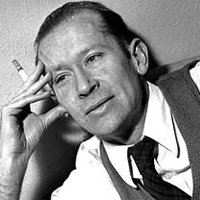my father moved through dooms of love by Edward Estlin Cummings: Summary and Critical Analysis
This poem 'my father moved through dooms of love' by Cummings is an elegy written after the death of the poet's own father, the Reverend Edward Cummings, a Unitarian minister and Harvard university professor. It is a poem about love. The poem does not so much explain it as demonstrate. Not simply recording the ideals of a real man, the poet chooses to embody his own highest ideals in a fictionalized character, describe him in action, and claims a sonship with him which makes clear his own intellectual and spiritual heritage.

E. E. Cummings (1894-1962)
Stanzas 1 to 4 make up the first section of the poem, which introduces the speaker’s father as a man of tremendous capacity for love. The first stanza gives a picture of a man who realized the danger of being rejected (“dooms”) the risk of losing one’s identity in a love relationship (“sames”) and the potential of a lover to become possessive or possessed (“haves”). He faced these dangers squarely and finally emerged as a whole man, capable of loving and being loved. In the next section (stanza 5 to 8) Cummings celebrates his father’s movement through “grief” into “joy”.
In the third section, (stanza 9 to 12) the father moves through “dooms of feel,” (He learns to accept and express the full range of human emotion.) Stanza 13 is about the challenge that his father undertook to make life happy and make others around him happy, despite another danger that of moving through “theys of we”, that is to conform to the social commonplaces just becoming another one among the ‘theys’. Stanza 14 suddenly takes a dramatic turn. After the positive tone of the description of his father, Cummings shifts to the harsh description of the society without his father that is after his death. Now the language is not of joy and singing but of “mud” and “scheming”, “fear” and “hate”. The language here is simpler; and evils exist right at the surface. The final stanza contains the moral: However great or small the evils of the world might be, the fact that one person-Cumming’s father- was able to embrace his humanity fully shows that the power of love is greater than the evils of the world. The love that exists as an active force in the world exerted by individuals is “more than all.” Cummings unifies each of the sections by threading through them the imagery of the passing of time and the cycle of birth, growth, death and rebirth. The imagery in the first section is about awakening and birth. The father operates at the renewal phase of the cycle in line 3: “Singing each morning out of each night.” Stanza 4 reminds the reader the passing of a day but also with the time it takes for a mountain to grow. Stanza 13, the last stanza dedicated to the father, shows the cycle completed. The imagery here is of spring come again. Stanza 14 to 16 presents a list of horrors, but there is no sense of cycle and rebirth. These last stanzas describe the hostile world without love and without his father.
Cite this Page!
Sharma, K.N. "my father moved through dooms of love by Edward Estlin Cummings: Summary and Critical Analysis." BachelorandMaster, 4 Nov. 2013, bachelorandmaster.com/britishandamericanpoetry/my-father-moved-through-dooms-of-love.html.
